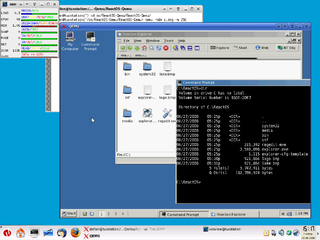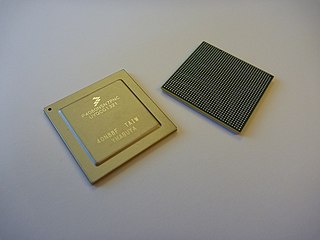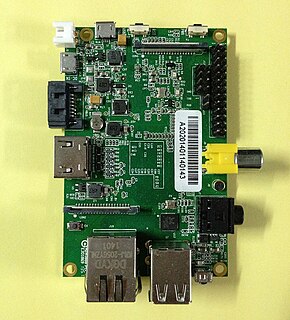
A motherboard is the main printed circuit board (PCB) in general-purpose computers and other expandable systems. It holds and allows communication between many of the crucial electronic components of a system, such as the central processing unit (CPU) and memory, and provides connectors for other peripherals. Unlike a backplane, a motherboard usually contains significant sub-systems, such as the central processor, the chipset's input/output and memory controllers, interface connectors, and other components integrated for general use.

In computing, an expansion card is a printed circuit board that can be inserted into an electrical connector, or expansion slot on a computer's motherboard to add functionality to a computer system. Sometimes the design of the computer's case and motherboard involves placing most of these slots onto a separate, removable card. Typically such cards are referred to as a riser card in part because they project upward from the board and allow expansion cards to be placed above and parallel to the motherboard.

The Power Macintosh G3 is a series of personal computers designed, manufactured, and sold by Apple Computer, Inc. from November 1997 to August 1999. It represented Apple's first step towards eliminating redundancy and complexity in the product line by replacing eight Power Macintosh models with three: Desktop and Mini Tower models for professional and home use, and an All-In-One model for education. The introduction of the Desktop and Mini Tower models coincided with Apple starting to sell build-to-order Macs directly from its web site in an online store, which was unusual for the time as Dell was the only major computer manufacturer doing this. Apple's move to build-to-order sales of the Power Macintosh G3 also coincided with the acquisition of Power Computing Corporation, which had been providing telephone sales of Macintosh clones for more than two years.

Pegasos is a MicroATX motherboard powered by a PowerPC 750CXe or PowerPC 7447 microprocessor, featuring three PCI slots, one AGP slot, two Ethernet ports, USB, DDR, AC'97 sound, and FireWire. Like the PowerPC Macintosh counterparts, it boots via Open Firmware.

Octane series of IRIX workstations was developed and sold by SGI in the 2000s. Octane and Octane2 are two-way multiprocessing-capable workstations, originally based on the MIPS Technologies R10000 microprocessor. Newer Octanes are based on the R12000 and R14000. The Octane2 has four improvements: a revised power supply, system board, and Xbow ASIC. The Octane2 has VPro graphics and supports all the VPro cards. Later revisions of the Octane include some of the improvements introduced in the Octane2. The codenames for the Octane and Octane2 are "Racer" and "Speedracer" respectively.

The Power Mac G4 is a series of personal computers designed, manufactured, and sold by Apple Computer, Inc. from 1999 to 2004 as part of the Power Macintosh line. Built around the PowerPC G4 series of microprocessors, the Power Mac G4 was marketed by Apple as the first "personal supercomputers", reaching speeds of 4 to 20 gigaFLOPS. This was the first existing Macintosh product to be officially shortened as "Mac", and is the last Mac able to boot into classic Mac OS.

The O2 was an entry-level Unix workstation introduced in 1996 by Silicon Graphics, Inc. (SGI) to replace their earlier Indy series. Like the Indy, the O2 used a single MIPS microprocessor and was intended to be used mainly for multimedia. Its larger counterpart was the SGI Octane. The O2 was SGI's last attempt at a low-end workstation.

Geode was a series of x86-compatible system-on-a-chip microprocessors and I/O companions produced by AMD, targeted at the embedded computing market.

QEMU is a free and open-source hypervisor. It emulates the machine's processor through dynamic binary translation and provides a set of different hardware and device models for the machine, enabling it to run a variety of guest operating systems. It can interoperate with Kernel-based Virtual Machine (KVM) to run virtual machines at near-native speed. QEMU can also do emulation for user-level processes, allowing applications compiled for one architecture to run on another.

The SPARCstation 20 or SS20 is a discontinued Sun Microsystems workstation introduced in March 1994 based on the SuperSPARC or hyperSPARC CPU. It is one of the last models in the SPARCstation family of Sun "pizza box" computers, which was superseded by the UltraSPARC design in 1995.
The Apple Network Server (ANS) was a line of PowerPC-based server computers designed, manufactured and sold by Apple Computer, Inc. from February 1996 to April 1997. It was codenamed "Shiner" and originally consisted of two models, the Network Server 500/132 and the Network Server 700/150, which got a companion model, the Network Server 700/200 with a faster CPU in November 1996.
Jiangsu Lemote Tech Co., Ltd or Lemote is a computer company established as a joint venture between the Jiangsu Menglan Group and the Chinese Institute of Computing Technology, involved in computer hardware and software products, services, and projects.
PowerQUICC is the name for several PowerPC- and Power ISA-based microcontrollers from Freescale Semiconductor. They are built around one or more PowerPC cores and the Communications Processor Module which is a separate RISC core specialized in such tasks such as I/O, communications, ATM, security acceleration, networking and USB. Many components are System-on-a-chip designs tailor-made for embedded applications.

QorIQ is a brand of ARM-based and Power ISA-based communications microprocessors from NXP Semiconductors. It is the evolutionary step from the PowerQUICC platform, and initial products were built around one or more e500mc cores and came in five different product platforms, P1, P2, P3, P4, and P5, segmented by performance and functionality. The platform keeps software compatibility with older PowerPC products such as the PowerQUICC platform. In 2012 Freescale announced ARM-based QorIQ offerings beginning in 2013.

Sam440, also known by Sam or its codename Samantha, is a line of modular motherboards produced by the Italian company ACube Systems Srl. The Sam440ep version is a motherboard based on the PowerPC 440EP system-on-a-chip processor which includes a double-precision FPU. It is made by AMCC. Their primary targets are the industrial and embedded markets, running operating systems such as Linux and AmigaOS 4.
Nvidia Ion was a product line of Nvidia Corporation intended for motherboards of low-cost portable computers. It used graphics processing units and chipsets intended for small products.

Sam460ex is a line of modular motherboards produced by the Italian company ACube Systems Srl. The machine was released in October 2010 and can run AmigaOS 4, MorphOS, or Debian GNU/Linux.
The Ultra 60 is a fairly large and heavy computer workstation in a tower enclosure from Sun Microsystems. The Ultra 60 was launched in November 1997 and shipped with Solaris 7. It was available in several specifications.

Banana Pi is a line of single-board computers produced by the Chinese company Shenzhen SINOVOIP Co., Ltd. and its spin-off Guangdong BiPai Technology Co., Ltd.. The hardware design of the Banana Pi computers was influenced by the Raspberry Pi and both lines use the same 40 pin I/O connector.

On June 26, 2007, Dell released the new Inspiron desktop series as a replacement to the Dell Dimension desktop computers.